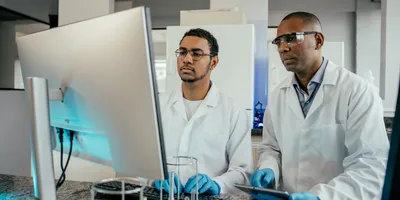On-the-job training (OJT) is a practical and effective approach to staff training. It enables staff to learn new skills and capabilities through doing the work hands-on under the helpful eye of an experienced colleague, one that has already demonstrated proficiency in the task.
OJT is an important component of lab cross-training activities and is often paired with shadowing. During shadowing, the learner watches the experienced colleague perform the task and is encouraged to ask questions throughout the training. After they have observed the task being properly completed, the roles reverse for OJT. Now the learner executes the task while being observed by the proficient colleague. The trainer will intercede and ensure that the work is completed properly. Once the learner can complete the task correctly consistently, the OJT training is complete.
On-the-job training components
OJT enables hands-on, experiential learning. This will complement any verbal or written training and will include any needed standard operating procedures (SOP) or standard methods. This training will be conducted in the lab with the equipment and tools required for the work, not in a classroom or office.
One of the key benefits of OJT is working closely with a proficient teacher. The teacher will offer suggestions, answer questions, and ensure that the work is completed properly. Working together to complete real work teaches far more than what is contained in a written description of the task.
The learner needs to focus on mastering the new activity and understanding the benefits to them and to the lab for learning this new skill. The goal of OJT is for them to demonstrate proficiency and no longer need the help of the trainer.
The trainer needs to have real proficiency in the task, the ability to communicate the elements and considerations of the task in plain language, and some patience. They will need to offer some grace and empathy to the learner. Everyone learns at a different pace. Some learners will need more support and repetition than others.
It is often beneficial to document the details of each OJT activity. This documentation will help improve written methods and procedures, help to evaluate the effectiveness of training, and provide a record for the staff training files in the quality system.
Benefits of on-the-job training
OJT is a cost-effective approach to training. The cooperative completion of the work enables a broad range of questions and answers between the participants. The discussion about the work allows for effective sharing of tacit knowledge that is difficult to capture in written methods and procedures. It is also much faster than someone trying to figure out a new skill on their own, supported only be written documents.
OJT is a component of increased employee engagement. It is an effective training method that enables staff to acquire new skills, enhance their capabilities, and receive constructive feedback from proficient individuals. This increased engagement will contribute to higher performance, greater productivity, and increased staff retention.
OJT will also help to share business-critical knowledge across staff. This helps protect the lab from unexpected absences and departures. The lab will have staff who can continue the work even if the primary owners of the knowledge aren’t there.
Advanced Lab Management Certificate
The Advanced Lab Management certificate is more than training—it’s a professional advantage.
Gain critical skills and IACET-approved CEUs that make a measurable difference.
OJT helps prepare staff for bigger roles. As they grow their skills and develop greater capability, they can participate in succession planning and be considered for opportunities like promotions and leading important projects.
Learning culture
OJT is a component of training that contributes to building a learning culture in the lab. Effective training will provide skills that are valued and needed by the lab, and that will be consistently used by the staff. It also helps to build valuable teaching skills within the staff. As people share their expertise, it becomes easier to ask for help and leverage the full range of expertise and experience in the lab.
OJT is an important training tool that links concrete and tacit knowledge. Especially combined with shadowing as part of an effective cross-training program, it helps staff learn and grow, helps to retain important organizational knowledge, and improves employee engagement. Investing in training programs fuels the lab to grow, develop, and better serve its key stakeholders.













